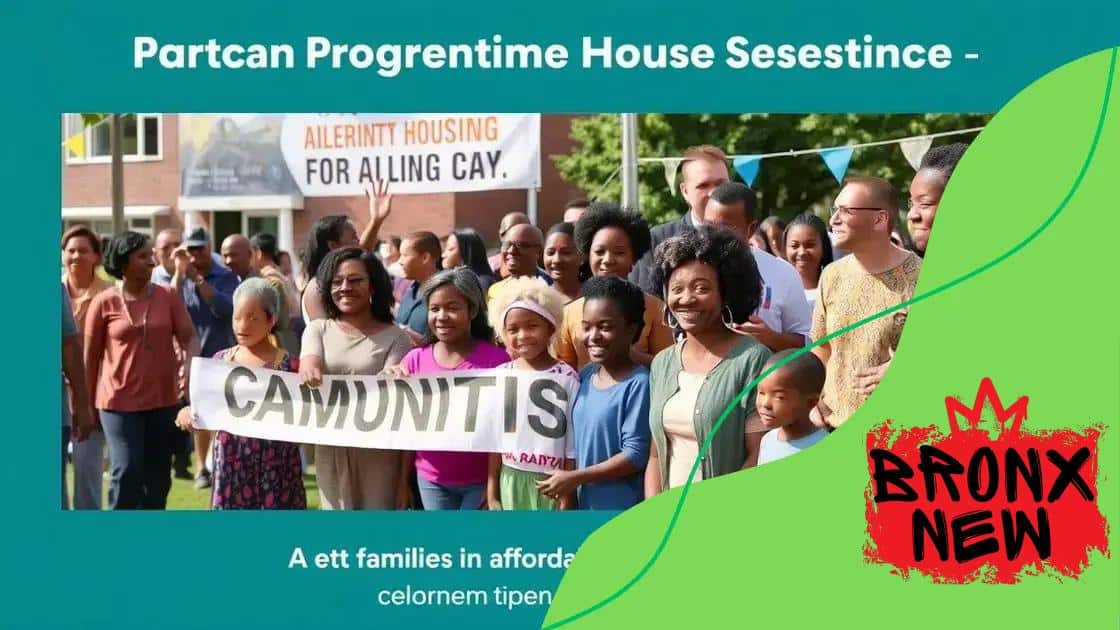Affordable housing initiatives for low-income families

Affordable housing initiatives for low-income families focus on creating accessible, safe housing options through innovative technologies, community involvement, and supportive policies, addressing critical challenges like rising costs and zoning restrictions.
Affordable housing initiatives for low-income families are crucial for fostering community stability. Have you ever wondered how these programs can transform lives and neighborhoods? Let’s dive into the details.
Understanding affordable housing initiatives
Understanding affordable housing initiatives is vital for addressing housing needs in our communities. These initiatives aim to provide low-income families with access to safe and affordable housing options.
Many organizations and government programs play crucial roles in creating and maintaining these housing solutions. For instance, public housing authorities and nonprofit organizations work together to ensure that housing remains affordable and accessible. Understanding these players can help us appreciate the complexity of the issue.
Key elements of affordable housing initiatives
Several key elements contribute to the success of affordable housing initiatives. From funding sources to community involvement, each aspect plays a significant role.
- Stable funding sources
- Collaboration between public and private sectors
- Engagement from local communities
- Long-term sustainability plans
In addition, effective programs often address more than just physical structures. They offer support services, such as financial counseling and job training, which empower families to build better futures. These holistic approaches lead to stronger communities overall.
Affordable housing initiatives also vary significantly between regions. Different areas have unique needs and resources, which influence the types of programs that are developed. For example, urban areas might focus on high-density housing, while rural locations may prioritize single-family homes.
Challenges faced in affordable housing initiatives
Despite the progress made, many challenges remain. Issues such as rising costs, zoning laws, and community resistance can hinder the development of new housing projects. Additionally, securing funding can be a constant struggle for organizations aiming to support low-income families.
Engagement from community members is essential. By voicing their needs and participating in the decision-making process, families can influence the types of affordable housing initiatives implemented in their neighborhoods. This participation boosts the success rates of these projects.
Key players in housing support
Key players in housing support include various organizations and individuals who work together to create and maintain affordable housing. These players are crucial for the success of any housing initiative aimed at helping low-income families.
Government agencies often serve as the backbone of housing support. They provide funding, set policies, and regulate housing programs to ensure they are effective and equitable. Local, state, and federal offices collaborate to address the unique needs of different communities.
Nonprofit organizations
Nonprofit organizations also play a vital role in affordable housing. These groups often focus on specific populations, such as veterans or the homeless, providing targeted support to those in need. Many nonprofits partner with government agencies to develop housing programs that offer not just shelter, but also supportive services.
- Funding assistance for low-income housing
- Emergency shelter programs
- Homebuyer education and counseling
- Advocacy for housing rights
Additionally, community organizations can help bridge gaps by connecting families with available resources. They often have a deep understanding of local needs and can address housing challenges effectively. By mobilizing community members, these organizations can enhance the impact of housing initiatives.
Developers and builders
Developers and builders are also essential players in the affordable housing landscape. They bring the vision of affordable housing to life by constructing new homes and rehabilitating existing properties. These professionals work closely with government and nonprofit organizations to meet specific housing needs.
Collaboration between these key players fosters innovation and helps to create more sustainable housing options. By pooling their resources and expertise, they can overcome challenges and expand access to affordable housing.
Finally, residents themselves are integral to the success of these programs, as their feedback and active participation ensure that housing meets their needs.
Case studies of successful programs

Case studies of successful programs illustrate how effective housing initiatives can make a significant difference for low-income families. These examples highlight the strategies and partnerships that lead to successful outcomes.
One notable program is the Housing First model, which prioritizes providing stable housing without preconditions. This approach has shown positive results in reducing homelessness. Communities that have implemented the Housing First model have reported improved mental health outcomes and greater stability in residents’ lives.
Collaborative programs
Another example comes from collaborative efforts between local governments and nonprofits. In many cities, initiatives combine resources to develop affordable housing. For instance, a city partnered with a nonprofit to create mixed-income housing projects. This collaboration has not only increased the number of available units but has also fostered a sense of community by ensuring diversity within neighborhoods.
- Utilization of public land for affordable housing
- Community engagement in the planning process
- Integration of social services within housing projects
- Long-term maintenance plans for sustained success
Studies also show that programs providing educational support alongside housing can have a multifaceted impact. For example, a program that offers families access to job training and financial literacy courses can significantly improve their quality of life. Such initiatives empower residents to increase their economic stability and independence.
Measuring success
To determine the effectiveness of these programs, communities often track key performance indicators. Metrics might include rates of homelessness, resident satisfaction, and the economic mobility of families involved. Regular assessment allows programs to adapt and improve continuously, ensuring they meet the changing needs of residents.
In conclusion, case studies provide valuable insights into best practices. Organizations can learn from these examples to implement their housing initiatives effectively, ultimately benefiting more families in need of affordable housing.
Challenges in implementing housing solutions
Challenges in implementing housing solutions can often hinder efforts to provide affordable options for low-income families. Understanding these challenges is key to developing effective strategies.
One major challenge is the rising costs of construction materials and labor. Prices can fluctuate greatly, making it difficult to budget for new housing projects. Additionally, when costs rise, it can limit the number of affordable units that can be built.
Zoning and regulatory hurdles
Zoning laws can also complicate the development of affordable housing. These laws dictate where new buildings can be placed and what type of structures can be built. In many areas, restrictive zoning regulations limit the construction of affordable units, because they prioritize single-family homes over multifamily dwellings.
- Lengthy permitting processes
- Strict building codes
- Local opposition to new developments
- Insufficient infrastructure to support new housing
Community opposition, often referred to as ‘not in my backyard’ (NIMBY) attitudes, can further exacerbate challenges. Residents might resist new housing developments due to fears about changes to neighborhood character or potential impacts on property values.
Funding limitations
Securing adequate funding remains a persistent issue. Many affordable housing projects rely on government grants, tax credits, or private donations. When funding sources are limited or inconsistent, it can stall development projects and reduce the availability of new homes.
Finally, even with successful implementation, maintaining affordable housing over time can be difficult. Properties require ongoing maintenance and management, and without sufficient funds, they may fall into disrepair, compromising the quality of housing available to families.
Future trends in affordable housing
Future trends in affordable housing are shaping the way we think about providing homes for low-income families. As the demand for affordable living spaces continues to rise, innovative solutions are emerging to tackle housing challenges.
One noticeable trend is the increasing use of technology in housing development. Smart home technologies are being integrated into affordable housing designs, enhancing energy efficiency and reducing utility costs. These technologies not only make homes cheaper to live in but also improve the quality of life for residents.
Modular and sustainable construction
Another trend is the shift toward modular and sustainable construction methods. Prefabrication allows for faster building times and reduced waste. By utilizing sustainable materials, developers can create homes that are environmentally friendly and cost-effective. This approach is gaining traction and is ideal for addressing urgent housing needs.
- Utilization of recycled materials
- Energy-efficient building designs
- Community gardens and green spaces
- Enhanced indoor air quality through better ventilation
Additionally, the focus on mixed-income developments is growing. These projects aim to integrate low-income families with diverse economic backgrounds, fostering inclusivity within neighborhoods. This model encourages a balanced community and reduces stigmas associated with affordable housing.
Policy changes and funding innovations
On the policy front, there is a push for changes aimed at fostering affordable housing. Governments are exploring alternative funding models, such as social impact bonds and public-private partnerships. These innovative funding sources allow for flexibility and creativity in housing solutions.
Moreover, communities are advocating for policies that promote zoning changes to allow for higher density and diverse housing options. These policy adjustments can make it easier to create affordable housing in urban areas where it is most needed.
As we look toward the future, addressing housing needs will require collaboration among government, developers, and community members. By embracing new trends and approaches, we can work to ensure affordable housing remains accessible for everyone.
FAQ – Frequently Asked Questions about Affordable Housing Initiatives
What are affordable housing initiatives?
Affordable housing initiatives are programs designed to create and maintain housing options for low-income families, ensuring they have access to safe and stable living environments.
How does community involvement impact affordable housing projects?
Community involvement is crucial as it allows local residents to voice their needs and preferences, leading to more successful and accepted housing solutions.
What role do government policies play in affordable housing?
Government policies can facilitate or hinder affordable housing through regulations, funding, and zoning laws, affecting how easily new developments can occur.
What are some challenges faced in developing affordable housing?
Challenges include rising construction costs, restrictive zoning laws, securing funding, and community opposition, all of which can delay or prevent housing projects.





